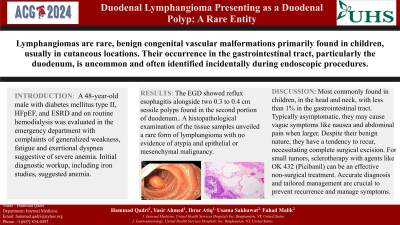Monday Poster Session
Category: Small Intestine
P3269 - Duodenal Lymphangioma Presenting as a Duodenal Polyp: A Rare Entity
Monday, October 28, 2024
10:30 AM - 4:00 PM ET
Location: Exhibit Hall E

Has Audio

Hammad Qadri, DO
United Health Services, Wilson Medical Center
Vestal, NY
Presenting Author(s)
Hammad Qadri, DO, Yasir Ahmed, MD, Ibrar Atiq, MD, Usama Sakhawat, MD, Toseef Javaid, MD, Fahad Malik, MD
United Health Services, Wilson Medical Center, Binghamton, NY
Introduction: Vascular malformations, like lymphangiomas, are a rare group of congenital malformations characterized by cystic dilation of thin-walled lymphatic vessels lined with epithelial cells. Usually diagnosed with the combination of endoscopy and radiology, these benign tumors with no malignant potential are often found in childhood and at cutaneous localizations, however the occurrence of these in the gastrointestinal (GI) tract especially duodenum is uncommon and often an incidental finding during esophagogastroduodenoscopy (EGD).
Case Description/Methods: A 48-year-old male with diabetes mellitus type II, heart failure with preserved ejection fraction (HFpEF) and end-stage renal disease (ESRD), on routine hemodialysis, was evaluated in the emergency department with complaints of generalized weakness, fatigue and exertional dyspnea suggestive of severe anemia. Initial diagnostic workup, including iron studies, suggested anemia. An EGD was performed to rule out a potential bleeding etiology before attributing the cause of anemia to a chronic disease. The EGD showed reflux esophagitis alongside two sessile polyps found in the second portion of duodenum that were resected with a cold snare. A histopathological examination of the tissue samples unveiled a rare form of lymphangioma with no evidence of atypia and epithelial or mesenchymal malignancy. The patient was continued on a proton pump inhibitor (PPI) daily for his esophagitis. Hemoglobin levels improved after blood transfusion, and NSAIDs, antiplatelets and anticoagulants were avoided to the decrease risk of bleeding.
Discussion: Lymphangiomas are rare benign fluid filled lymphatic lesions which are often missed on radiological images as they are difficult to distinguish from other lesions like lipomas, hemangiomas and leiomyoma. Most lymphangiomas present in the pediatric age group with more than 95% involving the head and neck region. Less than 1% of these tumors are found in the GI tract. Since these are submucosal tumors and often as small as < 1 cm, their diagnosis is done after excision and microscopic evaluation. Most tumors are asymptomatic or have vague and nonspecific symptoms like nausea, dyspepsia and abdominal pain. These symptoms usually present when the size of the tumor is large. Even though they have no malignant potential, they have a strong tendency for recurring and hence need to be completely excised. Non-surgical treatments include sclerosing agent like OK 432 (Picibanil) which has been used in eradication of small tumors.
Disclosures:
Hammad Qadri, DO, Yasir Ahmed, MD, Ibrar Atiq, MD, Usama Sakhawat, MD, Toseef Javaid, MD, Fahad Malik, MD. P3269 - Duodenal Lymphangioma Presenting as a Duodenal Polyp: A Rare Entity, ACG 2024 Annual Scientific Meeting Abstracts. Philadelphia, PA: American College of Gastroenterology.
United Health Services, Wilson Medical Center, Binghamton, NY
Introduction: Vascular malformations, like lymphangiomas, are a rare group of congenital malformations characterized by cystic dilation of thin-walled lymphatic vessels lined with epithelial cells. Usually diagnosed with the combination of endoscopy and radiology, these benign tumors with no malignant potential are often found in childhood and at cutaneous localizations, however the occurrence of these in the gastrointestinal (GI) tract especially duodenum is uncommon and often an incidental finding during esophagogastroduodenoscopy (EGD).
Case Description/Methods: A 48-year-old male with diabetes mellitus type II, heart failure with preserved ejection fraction (HFpEF) and end-stage renal disease (ESRD), on routine hemodialysis, was evaluated in the emergency department with complaints of generalized weakness, fatigue and exertional dyspnea suggestive of severe anemia. Initial diagnostic workup, including iron studies, suggested anemia. An EGD was performed to rule out a potential bleeding etiology before attributing the cause of anemia to a chronic disease. The EGD showed reflux esophagitis alongside two sessile polyps found in the second portion of duodenum that were resected with a cold snare. A histopathological examination of the tissue samples unveiled a rare form of lymphangioma with no evidence of atypia and epithelial or mesenchymal malignancy. The patient was continued on a proton pump inhibitor (PPI) daily for his esophagitis. Hemoglobin levels improved after blood transfusion, and NSAIDs, antiplatelets and anticoagulants were avoided to the decrease risk of bleeding.
Discussion: Lymphangiomas are rare benign fluid filled lymphatic lesions which are often missed on radiological images as they are difficult to distinguish from other lesions like lipomas, hemangiomas and leiomyoma. Most lymphangiomas present in the pediatric age group with more than 95% involving the head and neck region. Less than 1% of these tumors are found in the GI tract. Since these are submucosal tumors and often as small as < 1 cm, their diagnosis is done after excision and microscopic evaluation. Most tumors are asymptomatic or have vague and nonspecific symptoms like nausea, dyspepsia and abdominal pain. These symptoms usually present when the size of the tumor is large. Even though they have no malignant potential, they have a strong tendency for recurring and hence need to be completely excised. Non-surgical treatments include sclerosing agent like OK 432 (Picibanil) which has been used in eradication of small tumors.
Disclosures:
Hammad Qadri indicated no relevant financial relationships.
Yasir Ahmed indicated no relevant financial relationships.
Ibrar Atiq indicated no relevant financial relationships.
Usama Sakhawat indicated no relevant financial relationships.
Toseef Javaid indicated no relevant financial relationships.
Fahad Malik indicated no relevant financial relationships.
Hammad Qadri, DO, Yasir Ahmed, MD, Ibrar Atiq, MD, Usama Sakhawat, MD, Toseef Javaid, MD, Fahad Malik, MD. P3269 - Duodenal Lymphangioma Presenting as a Duodenal Polyp: A Rare Entity, ACG 2024 Annual Scientific Meeting Abstracts. Philadelphia, PA: American College of Gastroenterology.
